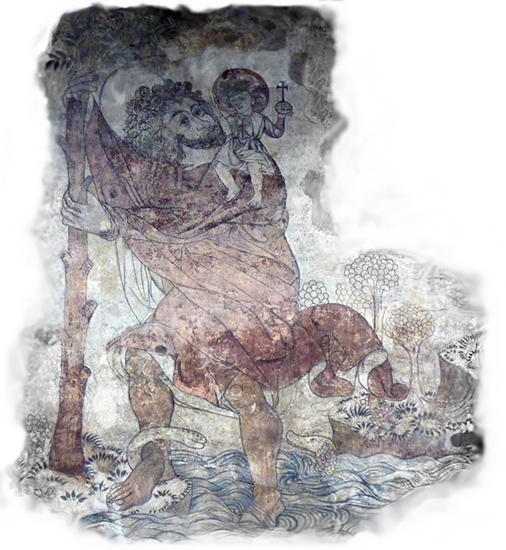Object Descriptions Tower House Chapel
Mural of St Christopher
On the west wall, facing the window, is a mural of St Christopher carrying the boy Jesus across the river. At his foot is a snake, representing sin and the devil, who is trodden underfoot.
St Christopher does not appear in the Bible but was popularized in late-medieval Europe by the Golden Legend of saints’ lives, written by Jacobus de Voragine in the mid-13th century. Artistic representations of Christopher appeared at the time in many countries, England and Ireland included.
No traces of wall paintings have been found at Kilcolman. This example is copied from a late medieval English mural, currently in St Peter’s and St Paul’s Church in Pickering, North Yorkshire, England. Any such mural at Kilcolman, had it existed, would not, presumably, have been commissioned by Spenser himself. More likely, it would have been a hold-over from previous, Catholic tenants such as the Desmonds, who as members of the “Old English” ethnic group claimed English and Welsh ancestry.
Religious murals are known to have been painted in Irish tower houses, and a few tantalizing remnants survive today. For example, St. Christopher with the Christ child is portrayed along with other images (including an ecclesiast, probably Bishop Colman) in a mural at the tower house of Ardamullivan, Co Galway. The tower house was held by a cadet branch of the O’Shaughnessy dynasty.

T. Crofton Croker describes (in 1824) fragments of frescoes he found in ruined Buttevant Friary (in Doneraile, near Kilcolman), which Spenser owned in 1598:
“Some traces of fresco painting are yet to be seen on the wall of one or two recesses in the nave:—a patchwork halo of red and yellow, confined by a strongly marked black outline, and part of an orange-coloured ladder with a bit of green drapery, however the antiquary may regard them, did not give my companions very high ideas of the state of excellence attained by the monastic professors of this art in Ireland.“
Irish saints typical for the Munster region in the medieval period would have included Patrick and Finbar. Kilcolman was named after St Colman of Cloyne, who flourished in the late sixth/early seventh century A.D. A small ruined church, Templetaggart Church, which may or may not be associated with St Colman, stands 1720 yards south of the castle, on the far side of the lake/bog. The fields to the north and northwest of the castle also held medieval churches named after the saint.
Photo credit: Jackie Selby Brooks
Bibliography:
T. Crofton Croker, Researches in the South of Ireland (London: John Murray, 1824): 115.
Andrew Hadfield, Edmund Spenser: A Life (Oxford: Oxford UP, 2012): 219, 222.
Karena Morton, “A Spectacular Revelation: Medieval Wall Paintings at Ardamullivan.” Irish Arts Review Yearbook 18 (2002), 104-13.
—, “Irish medieval wall painting.” Medieval Ireland: the Barryscourt Lectures I–X. Ed. J. Ludlow and N. Jameson (Kinsale: Gandon Editions, 2004), 313-49.
—, "Illustrating History." Irish Arts Review (Spring 2010), 96-101.
David Newman Johnson, “Kilcolman Castle.” The Spenser Encyclopedia (Toronto: U of Toronto P, 1990), 416-22: 419.